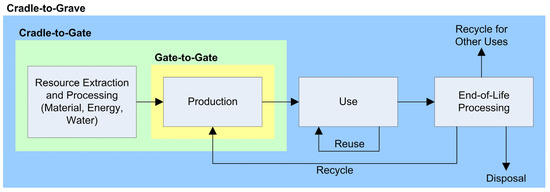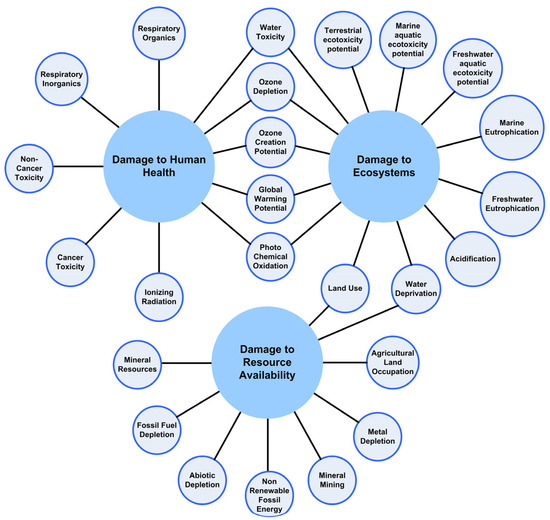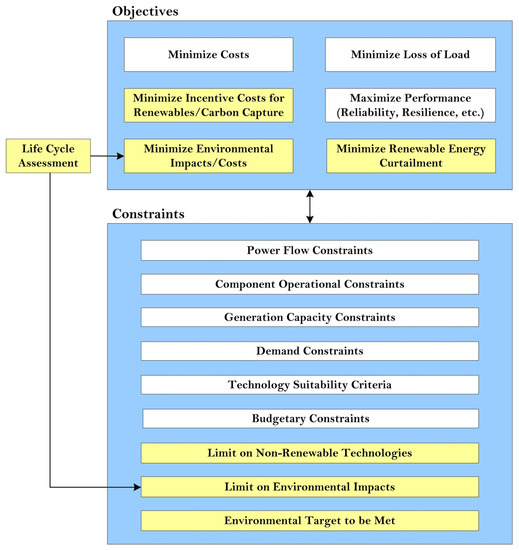In the most general sense, power grid capacity expansion can be formulated as an optimization model that tries to find the lowest cost solution to meet the expected electric demand over a long-term forecast horizon of typically 10–20 years. When it comes to devising generation capacity expansion, decision variables of the model may include additional generation capacity to be added to a subset of existing power plants and new power plants to be constructed at a subset of candidate locations. Because the added generation capacity needs to be transmitted to demand areas, often there is a need to construct new transmission lines or expand the capacities of the existing ones. Combining the two problems of generation and transmission expansion is beneficial because, when it comes to renewable energy resources, many times, the energy resource is available at a location from which proper connections to the main grid may not be available.
The changing climate and the rise in the frequency and severity of extreme weather events have created a consensus among the scientific community that materials and energy resources must be used in a sustainable fashion with minimal environmental impacts. In 2015, nations around the world signed the Paris Agreement pledging to combat climate change. To meet the strict goals developed in the agreement, many countries have begun transitioning their electric generation resources and grids away from fossil fuel-based technologies and instead, adopting clean and renewable energy generation alternatives such as hydropower, wind, or solar generation. With the pressure to decrease carbon emissions, many appliances and systems are being converted to utilize electricity as their primary energy source, e.g., EVs and electric heating. This trend is expected to continue, increasing the burden on electricity networks.
2. Modeling Sustainability through LCA
LCA is a sustainability modeling tool that quantifies the environmental impacts of a product or service over the course of its lifetime. It evaluates the environmental footprint by considering the inputs acquired from nature (e.g., material, energy, water) and the outputs to nature (e.g., waste, emissions to soil/water/air, etc.). LCA is meant to be utilized during the design and development of a product or service to identify environmentally harmful materials, processes, or activities associated with that product or service
[23]. After the identification of environmental harms, developers and engineers can consider alternate methods of design to ensure minimal impact on the environment. Alternatively, LCA can be used to compare two or more products in terms of their environmental footprints. Here, it is essential to define a functional unit to be used as the basis of comparison.
The international standards organization (ISO) series 14,040 defines and outlines the four phases of life cycle assessment
[23], which include goal and scope definition, inventory analysis, impact assessment, and interpretation. To clearly define the goal and scope of the assessment, the product system must be defined, the system boundary developed, and data categories chosen. Some LCA studies are reported as cradle-to-gate, which means that they only include impacts up to the point where the product is pushed out of the gate of the factory and do not consider negative effects that may arise from the product’s use or disposal. Other studies may focus on cradle-to-grave, which offers a comprehensive assessment of the impacts during manufacturing and production (upstream), operation, and disposal (downstream) of the product (see
Figure 1). Alternatively, an LCA study may only investigate the impacts associated with one process within the chain of production and use—an approach known as gate-to-gate.
Figure 1. LCA boundaries.
Inventory analysis is the section that calculates the amount of output materials or processes related to the inputs to the system through a unit process. Impact assessment evaluates the findings from the inventory analysis phase. The results are classified into
midpoint impact categories that may include acidification, freshwater eutrophication, ozone depletion, global warming potential, particulate matter, freshwater toxicity, land use, and mineral and fossil resources. These categories are then associated with
endpoint impact categories of damage to ecosystems, damage to human health, and damage to resource availability (see
Figure 2). The findings from LCA can be normalized or weighted depending on the scope of the study. Results can then be interpreted. An important aspect of interpretation of the results is an analysis of inconsistencies and key issues and limitations within data
[23].
Figure 2. Common midpoint and endpoint impact categories considered in LCA studies. Not all categories are included in all LCA studies. Moreover, some studies define new categories, which may be a combination of one or more categories listed above.
LCA can be
process-based, which uses inventory data for individual processes to methodically analyze material and energy flows at every stage of the life cycle, or
economic input-output-based (EIO), which uses economic data to assess impacts, for instance, identifying the level of emissions for $1M of sales in a particular industry
[24]. Generally speaking, process-based LCA is more appropriate for simpler and contained systems and studies, whereas EIO LCA is more suited for complex systems in which detailed environmental data about different processes may not be available with a high level of accuracy. A hybrid approach is also possible, where
rwe
searchers start with one model as the baseline and then fill the gaps with the second model to refine the analysis.
LCA can also be categorized as
attributional or
consequential. Attributional LCA (ALCA) uses current and historical data that is measurable/known to model the impacts and assumes that changes within the LCA system do not impact the overall techno-sphere
[24]. It models the system based on how things are and does not consider the effects of outside systems and policies on the system under study. Consequential LCA (CLCA), on the other hand, models the environmental impacts that might occur in the future in response to changes in technology, policy, or market. It performs a what-if analysis of the consequences of changes in the way a product is produced, used, and/or disposed of. CLCA analyses are more appropriate for large-scale studies.
3. Sustainable Power Grids: Capacity Expansion Models
To ensure sustainability in design and capacity expansion, some researchers have used the findings from LCA studies to inform, critique, and compare energy policies and decisions. For instance, authors in
[25][40] analyzed the effectiveness of energy transition plans of UK’s largest utility. Authors in
[26][70] adopted a similar approach but compared proposed grid mixes in 2030 versus 2010. In
[27][49], an LCA-based method was developed to help policymakers with deploying energy storage systems. In another study, authors in
[28][71] developed an LCA-based methodology for determining carbon tax incentives that only considered environmental impacts and not cost. Lastly, LCA can help influence policies and regulations within electricity markets by coupling with other models such as optimization, geospatial informatics, net energy analysis, building information, and network theory
[29][30][31][32][33][34][44,50,54,58,65,72].
Alternatively, many researchers have proposed sustainability-focused power grid capacity expansion planning with embedded objectives and/or constraints that model environmental impacts. These can be designed to encourage renewable generation technologies or to place limits on non-renewable alternatives (
Figure 3). Naturally, one of the easiest ways to expand the power grid in a sustainable fashion is to limit generation options to only renewables and disregard higher-polluting ones. This approach has been adopted by some authors, for instance, in
[10][35][36][37][10,63,73,74]. Alternatively, authors in
[38][75] proposed to incorporate the external costs of energy generation and transmission (e.g., costs due to environmental and societal damages) into the marginal production costs so that it impacts the supply and demand equilibrium. Authors in
[39][40][41][42][76,77,78,79] incorporated a cost term in the objective function to reflect emissions. In
[43][80], a carbon tax term was added to the cost objective function.
Figure 3. Sustainability-focused grid expansion planning model. Components highlighted in yellow represent objective functions and constraints that target sustainability goals.
Authors in
[44][81] introduced cost and revenue functions associated with carbon capture and storage (CSS) for non-renewable technologies. The cost was associated with the installation of the CSS technology, which also uses a nonnegligible portion of the electricity produced by the plant. The revenue was modeled to reflect selling the captured CO
2 as a commodity or tax credits received for capturing carbon.
If financial incentives are allocated to new renewable technologies, their costs need to be included in the model as well. For instance, authors in
[45][82] included a term in their cost function to reflect the incentive payments made by the utility. This term was a linear function of the level of demand reduction (in MW) and energy conservation (in MWh). The former variable was then included in the adequacy constraint, whereas the latter was included in the energy balance constraint. The authors argued that this enables the planning authority to design optimal rates of renewable integration and energy conservation targets.
Alternatively, installing new renewable plants can be incentivized indirectly by enforcing limits on emissions. Authors in
[42][46][47][79,83,84] modeled the problem as minimizing the cost of new technologies to be installed and introduced an additional constraint to limit the emissions from generation. However, as pointed out in the previous section, emissions only account for one aspect of the environmental impacts of new technologies, and an LCA-based approach is the only viable option to model all important undesired impacts. This has been the focus of some researchers in recent years. For instance, authors in
[34][72] developed an optimization framework for a case study in China to allocate energy resources that can supply the load with lower environmental impacts than the business as usual (BAU) model. They considered material input, GWP, and water deprivation as the impact categories. Their objective function was defined as the sum of environmental impacts per unit of each energy resource used to supply the demand, and the model was solved subject to constraints listed as the entire demand being met (overall power balance with no network constraints), limits on the levels of each of the environmental impact categories, and each environmental impact must reduce compared to BAU. The environmental factors for each technology were determined based on a cradle-to-grave LCA analysis. Authors in
[28][71] compared the cost-optimal study of the European power system based on carbon tax incentives with one in which the goal was to minimize environmental impacts, modeled based on a total of 18 indicators. They calculated the annual emissions as a function of the energy mix for 12 representative days in the year and concluded that shifting from an economic to an environment-focused model increased the share of renewables by 2.65% and decreased the overall emissions by 9%. Further, it resulted in upgrading the power grid to accommodate the renewables, leading to a 1.5% increase in the overall cost of the power system. In
[48][85], GHG emissions were incorporated into the grid capacity expansion planning by introducing a new objective function alongside the traditional cost minimization objective. Emission categories were calculated using LCA and combined into investment (for new generation capacity) and operation (for new and existing generation) categories. In their case study, the authors noted an 82% reduction in emissions at the expense of a 63% increase in cost. A similar approach was proposed in
[49][86], where generation expansion planning was combined with LCA into a multi-objective optimization framework. The impacts of the energy supply were divided into a fixed portion, reflecting the costs and impacts associated with the infrastructure construction as well as the upstream processes necessary, and a variable portion, which included costs and impacts associated with the production of electricity. The model was solved subject to constraints associated with power balance, unit capacity limits, and shutdown and start-up of generators, to name a few.
Sometimes the push towards sustainability is guided by a renewable energy target to be met. Authors in
[42][79] introduced constraints that reflected the desired renewable installed capacity and lower/upper bounds for regional expansion of capacity. A similar target for the actual (not nominal) renewable energy capacity was adopted as a constraint in
[41][78]. Authors in
[10] introduced a constraint in their model to reflect the wind energy target to be met each year: In each year, the capacity of each wind farm multiplied by its capacity factor, summed over all wind farms, must exceed that year’s wind penetration requirement.
Renewable energy resources are intermittent and stochastic in nature, making them different from fossil fuel plants from a reliability perspective. The capacity value of a generation resource, which is defined as the fraction of its rated capacity that is considered firm, should be included in the calculations for determining the amount of reserve margin and/or energy storage capacity needed. To address this, authors in
[42][79] modeled constraints that ensured that secured capacity was higher than peak load of the year. Authors in
[50][87] incorporated the capacity value of variable generation in the form of resource adequacy constraints. Alternatively, the uncertainties of the renewable energy resources can also be modeled in the form of stochastic-based optimization, where first-stage variables indicate installation decisions and second-stage variables concern the operation of the resource under different scenarios. One such example is reported in
[15].
Some researchers have also studied the suitability of various generation technologies. For instance, authors in
[42][79] included a suitability objective function modeled as distance to the river for cooling purposes of steam power plants, infrastructure for gas distribution/storage for gas turbines, etc. As another example, authors in
[51][88] developed a fuzzy logic model to rank various green energy alternatives for capacity expansion. They considered social (number of jobs created, balanced development across regions), technical (technology maturity, production capacity), environmental (land requirement, emission reduction), and economic factors (investment cost, affordability of cost of energy).
Other incentives have also been included in the capacity expansion model. As an example, authors in
[52][89] considered the potential of DERs (general resources, not focused on renewables) in reducing the peak load, which could allow for avoiding or delaying the need for capacity expansion (referred to as non-wire alternatives (NWAs)). They considered the timing of grid expansion as a variable, which could be affected by the contribution of those DERs, and investigated whether delaying or avoiding capacity expansion investments would balance the costs of NWAs.
Finally, as the modern distribution grid becomes equipped with a larger number of distributed energy resources, some authors argue that transmission and distribution planning problems need to be combined because, if solved in isolation, the solutions to each one would likely be suboptimal. Such approaches have been proposed, for instance, in
[15][53][15,90].



